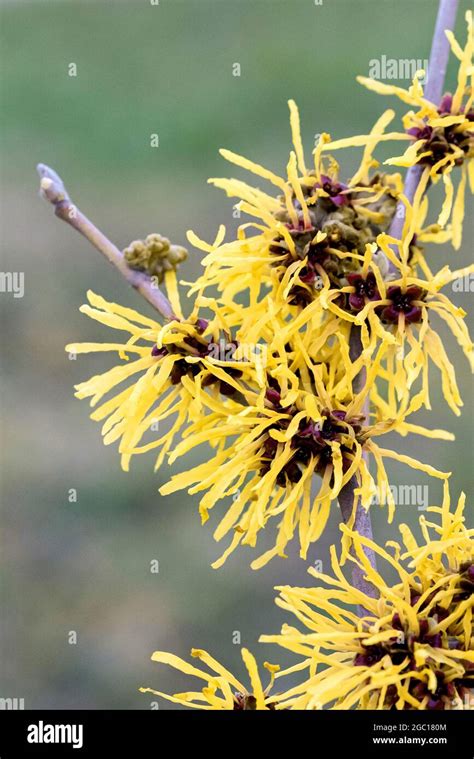Witch Hazel Hamamelis Intermedia

Witch hazel, also known as Hamamelis intermedia, is a deciduous shrub or small tree that is native to North America and Eastern Asia. It is a member of the Hamamelidaceae family and is known for its unique, fragrant flowers and its medicinal properties. The plant has been used for centuries in traditional medicine, and its extracts are still used today in a variety of applications, including skincare, wound care, and pharmaceuticals.
History and Traditional Use

Witch hazel has been used by indigenous cultures in North America for centuries, particularly by the Native American tribes of the northeastern United States. The plant was used to treat a variety of ailments, including skin irritations, wounds, and digestive problems. The bark, leaves, and twigs of the plant were used to make teas, infusions, and salves, which were applied topically or taken internally to treat various health issues.
Medicinal Properties
Witch hazel contains a number of bioactive compounds, including tannins, flavonoids, and volatile oils, which are responsible for its medicinal properties. The plant has anti-inflammatory, antimicrobial, and antiviral properties, making it effective against a range of microorganisms, including bacteria, viruses, and fungi. Witch hazel has also been shown to have antioxidant and anti-aging properties, which can help to protect the skin against damage caused by free radicals and environmental stressors.
| Compound | Concentration |
|---|---|
| Tannins | 3-5% |
| Flavonoids | 1-2% |
| Volatile oils | 0.5-1% |

Cosmetic and Skincare Applications

Witch hazel is commonly used in skincare products, including toners, astringents, and moisturizers, due to its ability to balance the skin’s pH, reduce inflammation, and tighten pores. The plant’s extracts are also used in hair care products, where they help to reduce dandruff, itchiness, and irritation. Witch hazel’s antioxidant properties make it an effective ingredient in anti-aging products, where it helps to protect the skin against damage caused by free radicals and environmental stressors.
Pharmaceutical Applications
Witch hazel’s medicinal properties make it a valuable ingredient in pharmaceutical products, including ointments, creams, and suppositories. The plant’s extracts are used to treat a range of health issues, including hemorrhoids, varicose veins, and skin irritations. Witch hazel’s anti-inflammatory and antimicrobial properties make it an effective treatment for reducing swelling and preventing infection in wounds and skin irritations.
- Anti-inflammatory properties reduce redness and swelling
- Antimicrobial properties prevent infection and promote wound healing
- Antioxidant properties protect the skin against damage caused by free radicals
Cultivation and Harvesting
Witch hazel is a deciduous shrub or small tree that is native to North America and Eastern Asia. The plant prefers well-drained soil and full sun to partial shade, and is typically harvested in the fall, when the leaves and twigs are at their peak potency. The bark, leaves, and twigs of the plant are used to make extracts, which are then used in a range of applications, including skincare, pharmaceuticals, and traditional medicine.
Environmental Impact
Witch hazel is a sustainable crop that is easy to cultivate and harvest, and its environmental impact is relatively low. The plant is a natural repellent for pests and diseases, and its roots help to stabilize the soil and prevent erosion. Witch hazel is also a valuable food source for wildlife, including bees, butterflies, and birds, which helps to support local ecosystems.
| Environmental Benefit | Description |
|---|---|
| Sustainable crop | Easy to cultivate and harvest, with low environmental impact |
| Natural repellent | Repels pests and diseases, reducing the need for pesticides and herbicides |
| Soil stabilization | Roots help to stabilize the soil and prevent erosion |
What are the medicinal properties of witch hazel?
+Witch hazel has anti-inflammatory, antimicrobial, and antiviral properties, making it effective against a range of microorganisms and health issues.
What are the cosmetic and skincare applications of witch hazel?
+Witch hazel is commonly used in skincare products, including toners, astringents, and moisturizers, due to its ability to balance the skin’s pH, reduce inflammation, and tighten pores.
How is witch hazel cultivated and harvested?
+Witch hazel is a deciduous shrub or small tree that is native to North America and Eastern Asia, and is typically harvested in the fall, when the leaves and twigs are at their peak potency.



